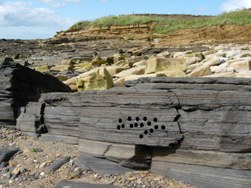 Colin MacFadyen, Scottish Natural Heritage, explains how SNH has responded to concerns over 'irresponsible' coring activities
Colin MacFadyen, Scottish Natural Heritage, explains how SNH has responded to concerns over 'irresponsible' coring activities
Geoscientist Online Special July 2012
Small diameter rock coring for the purpose of extracting samples for research has been a useful and necessary sampling technique employed by researchers for decades. However, following acts of thoughtlessness by some researchers that permanently defaced natural exposures ruining their photographic value, in 1989 the Geologists’ Association (GA) published the Code of Conduct for Rock Coring, a best practice guide to rock sampling by means of coring.
Picture: A classic example of the visual impact of irresponsible core sampling: the Sandwick Fish Bed near Stromness, Orkney. The bed can easily be traced into the intertidal area that would have offered abundant scope for sampling the lithology with minimal visual impact. However, the researcher chose to sample at the High Water Mark and despite there being less well exposed faces that could have been sampled from, chose to drill in the most obvious and highly visible faces which are evident to all that pass by this exposure. There was no effort expended to fill in the holes. In addition to the face shown, the top surface of the sequence and the face to the left (in shade), have similarly been disfigured. Colin MacFadyen/SNH.
Despite the existence of the GA Code, the disfiguring effects of irresponsible coring continue to this day. Worryingly, there are reports from around the world, including one from Scotland, of small scale geological structures no only being defaced, but having been annihilated by coring. It is not just geoscientists who are becoming alarmed at the level of irresponsible core sampling, as the cumulative effects of this otherwise efficient sampling method are becoming increasingly apparent to even the most casual observers. Irresponsible coring is tarnishing the reputation of geological science as well as damaging exposure, with the general public experiencing defaced outcrop in every setting imaginable – remote beaches and islands, mountain tops, and, lamentably, classic geological sections within statutory protected areas.
In response to the growing concern from geoscientists and the general public, SNH has produced and is promoting the Scottish Core Code for those planning to extract rock core samples from exposures in Scotland. The Code may be found
here. (See also below).
SNH is keen to establish and promote good practice guidance on the infilling of core holes and the means by which defaced rock exposure, particularly in classic geological sites, may be restored. This requires securing information on the techniques and methodology that have been used to date for different rock types, and how restoration attempts fare with time. If you are able to advise SNH in that respect we would very much like to hear from you. So far, we have only been able to garner information on what does
not work, such as silicone rubber mixed with sand and lichen used to restore a defaced palaeogene cone-sheet on the west coast. Needless to say that ill-considered effort did not last a winter!
Scottish Core Code
If rock coring in Scotland for palaeomagnetic, geological, geochemical and related studies, please follow the Scottish Core Code. All essential coring, either within or outside Sites of Special Scientific Interest (SSSI), should be carried out in a responsible and environmentally acceptable way.
Ask yourself: Is coring essential? Have you considered taking samples by means other than core extraction?
Seek permission: You are acting within the law if you obtain permission from the landowner to extract core samples.
Access responsibly: Consult the Scottish Outdoor Access Code prior to accessing land. Be aware that some locations are protected by law and there may be restrictions on access and sampling.
Core responsibly:
- To minimise visual impact take cores from surfaces that are hidden from view and do not deface the most obvious rock faces.
- Take only the minimum number of cores necessary and avoid closely spaced patterns.
- Plug the holes and make good the surrounding area: To help disguise the holes plug them using the weathered end of the core, or use rock chips and dust from the rock cored, mixed with cement or suitable resin.
Colin MacFadyen (PhD)
Policy and Advice Officer (Geologist)
Geodiversity, Uplands & Peatlands Group
Scottish Natural Heritage
Silvan House
231 Corstorphine Road
Edinburgh
EH12 7AT
Tel: 0131 316 2616
e-mail:
[email protected]